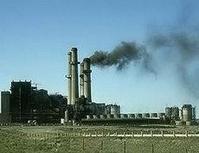Fossil Fuels发表评论(0)编辑词条
Fossil fuels or mineral fuels are fuels formed by the natural
resources such as anaerobic decomposition of buried dead organisms. The age of the organisms and their resulting fossil fuels is typically millions of years, and sometimes exceeds 650 million years. These fuels contain high percentage of carbon and hydrocarbons.
Fossil fuels range from volatile materials with low carbon:hydrogen ratios like methane, to liquid petroleum to nonvolatile materials composed of almost pure carbon, like anthracite coal. Methane can be found in hydrocarbon fields, alone, associated with oil, or in the form of methane clathrates. It is generally accepted that they formed from the fossilized remains of dead plants and animals by exposure to heat and pressure in the Earth's crust over hundreds of millions of years. This biogenic theory was first introduced by Georg Agricola in 1556 and later by Mikhail Lomonosov in the 18th century.
It was estimated by the Energy Information Administration that in 2006 primary sources of energy consisted of petroleum 36.8%, coal 26.6%, natural gas 22.9%, amounting to an 86% share for fossil fuels in primary energy production in the world. Non-fossil sources included hydroelectric 6.3%, nuclear 6.0%, and (geothermal, solar, wind, wood waste) amounting 0.9 percent. World energy consumption was growing about 2.3% per year.
Fossil fuels are non-renewable resources because they take millions of years to form, and reserves are being depleted much faster than new ones are being formed. The production and use of fossil fuels raise environmental concerns. A global movement toward the generation of renewable energy is therefore under way to help meet increased energy needs.
The burning of fossil fuels produces around 21.3 billion tons (21.3 gigatons) of carbon dioxide per year, but it is estimated that natural processes can only absorb about half of that amount, so there is a net increase of 10.65 billion tones of atmospheric carbon dioxide per year (one tonne of atmospheric carbon is equivalent to 44/12 or 3.7 tons of carbon dioxide). Carbon dioxide is one of the greenhouse gases that enhances radiative forcing and contributes to global warming, causing the average surface temperature of the Earth to rise in response, which climate scientists agree will cause major adverse effects.
Fossil fuels are of great importance because they can be burned (oxidized to carbon dioxide and water), producing significant amounts of energy. The use of coal as a fuel predates recorded history. Coal was used to run furnaces for the melting of metal ore. Semi-solid hydrocarbons from seeps were also burned in ancient times, but these materials were mostly used for waterproofing and embalming.
Commercial exploitation of petroleum, largely as a replacement for oils from animal sources (notably whale oil) for use in oil lamps began in the nineteenth century.
Natural gas, once flared-off as an un-needed byproduct of petroleum production, is now considered a very valuable resource.
Heavy crude oil, which is much more viscous than conventional crude oil, and tar sands, where bitumen is found mixed with sand and clay, are becoming more important as sources of fossil fuel. Oil shale and similar materials are sedimentary rocks containing kerogen, a complex mixture of high-molecular weight organic compounds, which yield synthetic crude oil when heated (pyrolyzed). These materials have yet to be exploited commercially. These fuels are employed in internal combustion engines, fossil fuel power stations and other uses.
Limits and alternatives
The principle of supply and demand suggests that as hydrocarbon supplies diminish, prices will rise. Therefore higher prices will lead to increased alternative, renewable energy supplies as previously uneconomic sources become sufficiently economical to exploit. Artificial gasolines and other renewable energy sources currently require more expensive production and processing technologies than conventional petroleum reserves, but may become economically viable in the near future. See Energy development. Different alternative sources of energy include nuclear, hydroelectric, solar, wind, and geothermal.
化石燃料,亦称矿石燃料,是一种碳氢化合物或其衍生物。化石燃料所包含的
天然资源有煤炭、石油和天然气。化石燃料的运用能使大规模工业发展和替代水车, 并且木材或泥煤燃烧加热。(西班牙语Combustible Fósil)
当发电的时候,在燃烧化石燃料的过程中会产生能量,从而推动涡轮机产生动力。旧式的发电机会使用蒸汽作为燃料推动涡轮机。现时,很多发电站都会直接使用燃气涡轮引擎的。
在踏入全球现代化的步伐20世纪至21世纪中,化石燃料潜在著能源短缺的危机,特别是从石油提炼出来的汽油,是引致全球石油危机的一个原因。现时,全球正趋向发展可再生能源和核能,这可以帮助增加全球的能源所需。
人类不断地燃烧化石燃料是排放温室气体二氧化碳的来源之一,是加快全球变暖的因素之一。此外,生物燃料中的二氧化碳成份是来自大气层,因此发展生物燃料可以减少在大气层上的二氧化碳,从而减低温室效应。
到目前为止,世界各国所用的燃料几乎都是化石燃料,即石油、天然气和煤。自然界经历几百万年逐渐形成的化石燃料,可能在几百年内全部被人类耗尽。据观察、研究表明,今天在地下已没有煤和石油在形成。
石油也叫原油,它是黄色到黑色的可燃性粘稠液体,常跟天然气共存,是很复杂的混合物。石油的性质因产地不同而不同,密度、粘度和凝固点的差别很大,例如,凝固点有的高达30℃,有的低到-66℃。热值从43.7~46.2MJ/kg。石油中各组分的沸点差别也很大,从25℃~500℃以上。石油里的主要元素是碳和氢,分别占83~87%和11~14%。此外还含有少量的硫(0.06~8%)、氮(0.02~1.7%)、氧(0.08~1.8%)以及微量金属元素(镍、钒、铁、铜)等。天然气从广义上讲,指埋藏在地层中自然形成的气体的总称。但通常所指的天然气只指贮藏在地层较深部的可燃性气体(气态的化石燃料)和跟石油共存的气体(常称油田伴生气)。天然气的主要成分是甲烷。此外,根据不同的地质条件,还含有不同数量的乙烷、丙烷、丁烷、戊烷、己烷等低碳烷烃以及二氧化碳、氮气、氢气、硫化物等非烃类物质。有的气田中还含有氦气。甲烷含量高的天然气叫干气,两个或两个以上碳原子烷烃含量较高的天然气称为湿气。我国四川自贡盛产天然气。
煤也叫煤炭,它是埋藏在地下的固态可燃性矿物。煤是一种混合物,没有单一的分子结构,经过科学家长期研究,已经有煤结构的普通型式介绍。煤的结构里有大量的碳原子环,一些环相互稠合,另一些环键合成长链。比较常见的有W.H.怀泽的烟煤结构模型,但都还没有能揭示煤的实质结构。煤中有机质元素主要是碳,其次是氢,还有氧、氮和硫等元素。
与“Fossil fuels,化石燃料”相关的词条
→如果您认为本词条还有待完善,请 编辑词条
词条内容仅供参考,如果您需要解决具体问题
(尤其在法律、医学等领域),建议您咨询相关领域专业人士。
1
标签: Fossil fuels 化石燃料

同义词: 暂无同义词
关于本词条的评论 (共0条)发表评论>>









